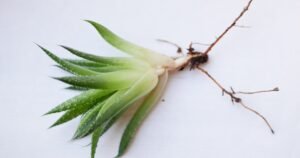With their fascinating shapes and striking appearances, succulents have become popular houseplants. However, when succulent leaves turn yellow and brown, it raises concerns among plant enthusiasts.
In this comprehensive guide, we will explore the potential reasons behind succulent leaves adopting these undesirable colors and offer insights on addressing and preventing this issue.
Potential Causes of Color Change in Succulent Leaves
Succulent Leaves Turning Yellow and Brown? The color change in succulent leaves can be attributed to various factors, including overwatering, insufficient light, temperature fluctuations, pest infestations, and nutritional deficiencies.
Overwatering is one of the most common mistakes succulent owners make, often leading to root rot and causing the leaves to turn yellow or brown.
Insufficient light can lead to etiolation, where the plant stretches toward the light source, resulting in discoloration and a slight appearance.
On the other hand, harsh sunlight can cause sunburn, turning the leaves brown.
Temperature fluctuations can cause stress to the plant, leading to discoloration.
In addition, pests such as aphids, mealybugs, and spider mites can suck the sap out of the leaves, causing them to yellow and wilt.
Lastly, a lack of essential nutrients can lead to deficiencies, which may manifest as discoloration in the leaves.

1. Natural Leaf Aging
Normal Aging Process:
- Explanation: Like all plants, succulents undergo a natural aging process. As the leaves age, they often turn yellow or brown, eventually drying out and falling off.
- Solution: Prune the older leaves to maintain the plant’s appearance and encourage new growth.
2. Watering Issues
Overwatering:
- Explanation: Overwatering is a common cause of succulent leaves turning yellow and later brown. When the roots absorb more water than the plant needs, the leaves swell, become yellow, and eventually rot, turning brown.
- Solution: Adjust your watering schedule to allow the soil to dry out between waterings. Use well-draining soil and pots with drainage holes to prevent excess water accumulation.
Underwatering:
- Explanation: Underwatering can also lead to yellowing and browning of succulent leaves. Insufficient water causes the leaves to dry out and turn yellow before eventually browning and becoming crispy.
- Solution: Develop a consistent watering routine, ensuring moist soil during each session. Monitor the moisture level and adjust the frequency based on the plant’s needs.

3. Lighting Conditions
Insufficient Light:
- Explanation: Succulents need ample sunlight to maintain their vibrant colors and health. Insufficient light can cause the leaves to lose color, turn yellow, and potentially brown.
- Solution: Place your succulents in a well-lit area, preferably near a south-facing window where they can receive at least 6 hours of sunlight daily. Consider using grow lights to supplement their lighting needs if natural light is limited.
Excessive Sunlight:
- Explanation: Too much direct sunlight, especially during peak hours, can scorch the leaves, causing them to turn yellow and eventually brown.
- Solution: Provide filtered or indirect sunlight to protect your succulents from intense sunlight. Consider moving them to a slightly shaded area during the hottest parts of the day.
4. Temperature Extremes
Extreme Cold:
- Explanation: Exposure to extreme cold can cause succulent leaves to turn yellow and brown as the cells freeze and rupture.
- Solution: Move your succulents indoors or to a sheltered area during colder months or if frost is expected. Ensure they are not placed near cold drafts or heating vents.
Extreme Heat:
- Explanation: Prolonged exposure to high temperatures can cause succulent leaves to turn yellow and brown. Heat stress can damage the cells and affect the plant’s health.
- Solution: Protect your succulents from intense heat by providing shade during the hottest part of the day. Adequately water them to help them cope with high temperatures.
5. Soil Issues
Poor Quality Soil:
- Explanation: Using soil that doesn’t provide proper drainage can lead to soggy roots and root rot, causing the succulent leaves to turn yellow and mushy.
- Solution: Use a well-draining succulent or cactus-specific soil mix to ensure excess water can easily escape, preventing root rot.
Compacted Soil:
- Explanation: Compacted soil can lead to poor aeration and water retention, causing the roots to suffocate and the leaves to turn yellow and brown.
- Solution: Regularly loosen the soil around the succulent’s roots to improve aeration and ensure the soil remains loose and well-draining.

6. Disease and Pests
Fungal Infections:
- Explanation: Fungal infections, often resulting from excess moisture or poor ventilation, can cause yellowing and browning of succulent leaves.
- Solution: Treat fungal infections with appropriate fungicides and ensure good air circulation by spacing out plants and avoiding overcrowding.
Posts:
- Explanation: Pests like mealybugs, spider mites, or aphids can damage succulent leaves, causing them to turn yellow and brown.
- Solution: Inspect your succulents regularly for signs of pests and treat infestations with insecticidal soap or neem oil. Isolate-affected plants to prevent the spread of pests.
7. Nutritional Deficiencies
Lack of Nutrients:
- Explanation: A deficiency in essential nutrients, particularly nitrogen, can cause succulent leaves to turn yellow or brown as the plant struggles to maintain its metabolic functions.
- Solution: Use a balanced succulent fertilizer and follow the recommended feeding schedule to ensure your succulents receive nutrients.
8. Transplant Shock
Transplant Stress:
- Explanation: Moving succulents to a new pot or changing their growing environment can cause temporary stress, leading to yellowing or browning of the leaves.
- Solution: Allow the succulent to acclimate to its new environment. Limit watering and avoid direct sunlight for a few days after transplanting.
9. Genetic Factors
Genetic Predisposition:
- Explanation: Some succulent varieties may naturally exhibit yellowing or browning of leaves due to their genetic makeup.
- Solution: Ensure you provide optimal care for your specific succulent species and variety. If it’s a genetic trait, embrace the unique characteristics of your plant.
Conclusion
Succulent Leaves Turning Yellow and Brown? Caring for succulents entails understanding the various factors affecting their health and vitality. Yellowing or browning of leaves is a common concern, often traced back to issues like improper watering, extreme temperatures, inadequate lighting, soil problems, diseases, pests, nutritional deficiencies, transplant shock, or even genetic factors. You can ensure they thrive and display their unique beauty by identifying the specific cause, adjusting care practices accordingly, and maintaining an optimal environment for your succulents. Remember, each succulent variety may require slightly different care, so it’s crucial to understand the specific needs of your plants.
FAQs
How do you fix yellow leaves on succulents?
Yellow leaves on succulents can be rectified by first identifying the underlying cause. Issues could range from watering problems and light conditions to temperature extremes, soil problems, pests, diseases, nutritional deficiencies, transplant shock, or genetic factors. Once the cause is known, adjust care practices: amend the watering schedule, adjust light exposure and moderate temperatures, employ pest control methods, or supplement with the needed nutrients. Patience is key, as recovery may take time.
Why is my succulent turning yellow and brown?
Succulents turning yellow and brown can be due to various reasons such as overwatering, inadequate light, extreme temperatures, soil issues, pests or diseases, nutrient deficiencies, transplant shock, or specific genetic traits. Identifying the exact cause and adjusting the care practices can help restore the plant’s health. However, each succulent species is unique and may require slightly different care.
Why are the leaves on my succulents turning brown?
Leaves on succulents may turn brown due to various reasons, including scorching from direct sunlight, overwatering, or underwatering, causing the cells in the leaves to die. In some cases, pests or diseases could be responsible. Identifying the cause and taking appropriate measures can help revive the plant’s health. However, note that browning due to genetic factors might be irreversible.












